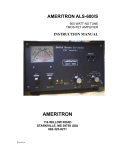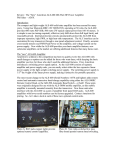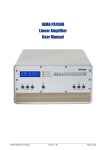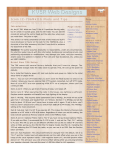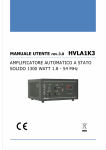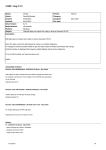Download AMERITRON ALS-500M Instruction manual
Transcript
AMERITRON ARI-500 Automatic Band Switch For ALS-500 INSTRUCTION MANUAL PLEASE READ THIS MANUAL BEFORE OPERATING THIS EQUIPMENT ! 116 Willow Road Starkville, MS 39759 USA 662-323-8211 Version 1A Printed in U.S.A. ARI-500 Automatic Band Switch for ALS-500 Instruction Manual Contents Introduction............................................................................................................ 2 Features ................................................................................................................. 2 Specifications......................................................................................................... 2 Installation ............................................................................................................. 2 Operating ALS-500RC with the ARI-500 ............................................................ 3 Interfacing ARI-500 to Radio for keying and Band Data …. ................................ 4 Interfacing to Icom Radios ................................................................................... 5 Interfacing to Yaesu Radios ................................................................................. 6 Interfacing to Kenwood Radios ........................................................................... 7 Operation ............................................................................................................. 8 Technical Assistance.............................................................................................. 10 Schematic............................................................................................................... 11 Warranty ................................................................................................................ 15 2 ARI-500 Automatic Band Switch for ALS-500 Instruction Manual Ameritron ARI-500 Introduction Congratulations on your choice of the Ameritron ARI-500 Automatic Band Switch for the Ameritron ALS-500M Amplifier. The ARI-500 is designed to automatically select the correct frequency range on the amplifier by reading the frequency or band data from the transceiver. This automatic switch is compatible with most Icom, Yaesu, and Kenwood transceiver. Some other radios may also be compatible. Features PWR: Green LED indicates the amplifier and transceiver is connected correctly LINK: Red LED indicates information is being received from transceiver. RADIO: RJ-45 Jack for interfacing to the transceiver. AMP A/B: RJ-45 Jacks for interfacing to the ALS-500M REMOTE A/B: RJ-45 Jack for use with the optional ALS-500RC Specifications Receives power from the ALS-500M interface cables. Dimensions 4.5” W x 1.5” H x 4.25 D Weight 0.4 lbs Installation The ARI-500 connects to the Remote A/B jack on the front of the amplifier. Two RJ-45 cables are supplied to connect jack A and B from the ARI-500 to the remote A/B on the ALS-500M. 1. 2. 3. 4. 5. Place the ARI in a suitable location. Ensure the Amplifier switch is off and the frequency select switch is in the Remote position. Plug one of the patch cords into AMP A of the ARI-500. Route the other end to the ALS-500M and connect to Remote A. Plug the other patch cord into AMP B of the ARI-500. Route the other end to the ALS-500M and connect to Remote B. Set the ALS-500M’s Frequency Select Switch to Remote Position. Operating ALS-500RC with the ARI-500 (OPTIONAL) 3 ARI-500 Automatic Band Switch for ALS-500 Instruction Manual Skip this section and go to interfacing ARI-500 to radio for keying and band data, if the ALS-500RC will not be used. The optional ALS-500RC remote head can be used with the ARI-500. The ALS-500RC will display the current, power on, TX and O/L of the amplifier. The following is for using the ALS-500RC Remote Head with the ARI-500: 1. Connect a patch cable to Remote port A of the ARI-500. 2. Connect the other end to port A of the ALS-500RC remote. 3. Port B is not used during this application. Note: JMP 2 inside the ARI-500 determines the function of the ALS-500RC . A. JMP 2 in the 1 to 2 position (Fig. A) will allow the Auto O/L Reset, and Current Meter to work, the Power, TX and O/L indicators to operate. The ALS-500RC’s Power Switch will have to be in the on position for the indicators to function. The power switch will not turn the amplifier off. It will only turn the power to the remote off. Refer to the Amplifier’s manual for turning the amplifier’s power off. Figure A. (Factory default) JMP 2 JMP 2 B. JMP 2 in the 2 to 3 position (Fig. B) will allow the Current Meter, Power, TX and O/L indicators to function. The Auto O/L Reset will not work. The O/L will have to be reset by switching the ALS-500RC’s Power Switch off and back to on. The ALS-500RC power switch will turn the ALS-500M’s power off. When the power is switched to on allow 4 seconds for the amplifier to turn on. Figure B. Interfacing ARI-500 to Radio for keying and Band Data 4 ARI-500 Automatic Band Switch for ALS-500 Instruction Manual The ARI-500 is compatible with most Icom, Kenwood and Yaesu radios for reading band data information and detecting transmitter keying. Newer Kenwoods have a DB-9 connector for computer control. Serial data is read from this port to get the band data. Icom Transceivers use a “step voltage” to output band data. A voltage of 0-8 volts is output from the band data pin of the accessory jack. Yaesu, older Kenwoods, and others outputs band data in a 4 line BCD format. Many other transceivers use this standard. If your transceiver is not one that is listed, check in your instruction manual to see if it has a BCD output that is similar to that of Yaesu. Interfacing ARI-500 to Radio for Keying and Band Data The ARI-500 Radio Input connection is a RJ-45 jack that has specific connections of each radio brand. The diagram below shows the pin-out of the Radio Input jack. See the specific section below for more information on interfacing to each particular radio brand. Rear Panel View 12345678 1 Ground 2 Key In 3 Kenwood RX 4 Kenwood TX / Yaesu BCD D 5 Yaesu BCD C 6 Yaesu BCD B 7 Yaesu BCD A / Icom Power 8 Icom Band Data NOTE: Multiple radios cannot be connected to the ARI-500 at the same time. The ARI-500 is designed to operate with only ONE radio. Interfacing to Icom Radios In order to retrieve band data from Icom radios, the ARI-500 must be connected to the band data voltage output. This can be found on the ACC 5 ARI-500 Automatic Band Switch for ALS-500 Instruction Manual jack on the back of the radio. This 13-pin jack has the band data voltage, amp key out (goes to ground when the radio is transmitting), power with voltage when on, and ground. The diagram below shows the connections required between an Icom radio and the ARI-500. Connection to an ICOM IC-7000 requires an ICOM approved modification. Follow the instructions included with your IC-7000(page 140) to make the modification. Ameritron will not be held liable for any damage caused by this modification to an IC-7000 transceiver. ICOM 706/718/7000* Rear View of ICOM radio 13 9 1 0 11 1 2 5 6 7 8 1 2 3 4 Rear View of ARI-500 Gnd 13.8V ARI-500 Amp Key 12345678 Band Data Radio Input *IC-7000 requires modification for ARI-500 operation . See paragraph above. ICOM 746/756 13.8V Band Data ARI-500 Gnd Rear View of ICOM radio 4 2 5 3 1 6 7 Rear View of ARI-500 Amp Key 12345678 Radio Input Connection Band Data Voltage Icom Power (13.8V) Amp Key / HSend Ground 6 ARI-500 Radio Input Pin 8 Pin 7 Pin 2 Pin 1 ARI-500 Automatic Band Switch for ALS-500 Instruction Manual Interfacing to Yaesu Radios Yaesu radios output band information using a 4-line BCD format. The band data lines can be found on the Linear port on most Yaesu radios. Some radios share the CAT port with the Linear port. The radio must be configured so that the port is in Linear mode or the band data information will not be sent to the ARI-500. Check your radio’s manual to determine proper configuration of the Linear port. The diagram below shows the connection to the ARI-500. Double check with your radio’s manual to ensure the correct connections for the Band Data. Yaesu FT-857/897 ARI-500 Linear Port Rear View of Yaesu Transceiver 8 7 6 5 4 3 2 1 TX Gnd BCD D BCD C Gnd BCD B Yaesu FT-100D 12345678 Rear View of ARI-500 Radio Input BCD A ARI-500 Linear Port BCD A TX Gnd Gnd Rear View of Yaesu Transceiver 1 Rear View of ARI-500 2 3 4 5 6 7 8 BCD B 12345678 Radio Input BCD C BCD D Connection ARI-500 Radio Input Band Data A Band Data B Band Data C Band Data D Amp Key / TX GND Ground Pin 7 Pin 6 Pin 5 Pin 4 Pin 2 Pin 1 Yaesu Linear Socket Pin 4 Pin 5 Pin 6 Pin 7 Pin 2 Pin 3 7 ARI-500 Automatic Band Switch for ALS-500 Instruction Manual Interfacing to Kenwood Radios The Computer port (CAT) is used to retrieve the frequency of the radio. When the ARI-500 is first turned on, the “Auto Information” (AI) command is sent to the radio. This command causes the Kenwood radio to output the state of the radio (frequency, mode, etc) anytime the state has changes. The ARI-500 then uses the frequency to determine the appropriate band and then selects the correct antenna. The diagram below shows how to connect a Kenwood radio with a DB-9 Com port to the ARI-500. Note that pin 7 and 8 (RTS, CTS) on the Kenwood port are connected together. This ensures that the Kenwood will send the status information to the ARI-500. The Remote port is also found on the back of the Kenwood which has the amp key line needed for the ARI-500. There is one second delay from when the status of the radio changes until it is sent out over the serial connection. Kenwood TS-570, TS-870, TS-2000, (*TS-480 see Addendum in rear of this manual) Com Port 9 8 7 6 5 43 2 1 ARI-500 TXD Amp Key RXD Rear View of Kenwood Transceiver 4 2 5 1 Remote 3 6 Rear View of ARI-500 Gnd 12345678 7 Radio Input ARI-500 (Radio Input) RJ-45 Connector Wiring Pin 1 Ground connects to pin 1 of Radio Com port and pin 2 of Radio Remote Connector . Pin 2 Amp key connects to pin 4 of Radio Remote Port. Pin 3 (RXD ) connects to pin2 of RadioCom Port Pin 4 (TXD) connects to pin 3 of Radio Com Port. Pin 5 not connected. Pin 6 not connected. Pin 7 not connected. Pin 8 not connected. Pin 9 n ot connected. Note: Pins 7 and 8 on the Kenwood Com Port must be connected together. This ensures the radio will send information to the ARI-500. * The Kenwood TS-480 requires different connections. See the Addend in the rear of this manual. 8 ARI-500 Automatic Band Switch for ALS-500 Connection Kenwood RXD Kenwood TXD Amp Key Ground Instruction Manual Kenwood Interface to ARI-500 ARI-500 Radio Kenwood Com Input Port Pin 3 Pin 2 Pin 4 Pin 3 Pin 2 Pin 1 Pin 5 Kenwood Remote Port Pin 4 Pin 2 Operation The ARI-500 has an Auto Reset for the amplifier’s load fault (O/L). When the amplifier goes into load fault mode, the ARI-500 will wait 5 seconds and then switch the amplifier’s Power off and back to on for operation. The ARI-500 will reset the amplifier overload up to 3 times in a 5-minute period. If the amplifier load faults more than 3 times in a 5 minute period the amplifier’s power will have to be manually switch off for reset. JMP3 set to 2 and 3 will turn the Auto Reset off. Fig C Switching the ALS-500M’s Power On/Off will still be the same as with out the ARI-500M. Refer to the ALS-500M operation manual for remote on/off operation. If the Remote ALS-500RC is going to be used refer to Operating ALS-500RC with the ARI-500. The amplifier’s power switch will need to be in the off position for the Auto Load Fault reset to work. The amplifier will now be keyed by the ARI-500 for transmit and receive. The relay jack on back of the amplifier will not be used. The Amplifier’s Frequency Select Switch should be in the Remote Position. 22.5 to 30 MHz (10/12 Meter) Operation The ARI-500 has a jumper labeled JMP1. The JMP1 is for operation on frequencies between 22.5 and 30 MHz (AUX). The factory default is in the off position (2 to 3). The off position will prevent the amplifier from operating when the transceiver is in the 10/12 Meter band. Move JMP1 to ON, if the amplifier has the 10 Meter kit installed. See Fig C. ON Figure C. OFF O/C RESET ONLYJMP 3 AUX JMP 1 9 ARI-500 Automatic Band Switch for ALS-500 Instruction Manual The PWR and Link indicator lights will illuminate when transceiver and amplifier are connected and turned on. The Red LED marked Link will blink rapidly if the radio jack does not receive information from the transceiver. Note About Kenwood Radios Since the Radio Control Port is used to get the band information from the radio. The radio must be switched on first before powering up the ARI-500. Upon power up, the ARI-500 sends the Auto Information (AI) command to the Kenwood radio. This instructs the Kenwood to send the radio’s status information anytime it changes. Failure to do this will result in the radio not receiving this command and the ARI-500 not detecting a properly connected radio. Anytime the status of the radio changes, there is a one second delay before the new information is sent over the serial line to the ARI-500. This causes the switch to appear to respond slowly to the band changes. This is a result of the delay from the Kenwood radio, NOT the ARI-500. Technical Assistance If you have any problem with this unit first check the appropriate section of this manual. If the manual does not reference your problem or reading the manual does not solve your problem, call Ameritron at 662-323-8211. We can only help if you have your ARB-704 manual, radio manual, and information about your station available during the call. We strongly recommend calling Ameritron with any questions, but questions can be mailed directly to Ameritron at 116 Willow Road, Starkville, MS 39759 or Faxed to 662-323-9810. Please be aware that MFJ is a separate facility, and as such does not always offer the best assistance with Ameritron products. Be sure to send a complete description of the problem, explain how this unit is being used, and include a complete description of your station. NOTES: 10 ARI-500 Automatic Band Switch for ALS-500 Instruction Manual Schematic 11 ARI-500 Automatic Band Switch for ALS-500 12 Instruction Manual ARI-500 Automatic Band Switch for ALS-500 Instruction Manual 13 ARI-500 Automatic Band Switch for ALS-500 Instruction Manual ADDENDUM Connecting the ARI-500 to the Kenwood TS-480 12345678 Kenwood Com Port (Front View) Kenwood Remote Port Connection ARI-500 Radio Jack Kenwood Com Port Kenwood RXD ARI-500 Radio Input Pin 3 Pin 2 Kenwood Remote Port N/C Kenwood TXD Pin 4 Pin 3 N/C Amp Key Pin 2 N/C Pin 4 Ground Pin 1 Pin 5 Pin 2 & Shield The ARI-500 receives band information over the serial interface, while amplifier keying comes from the remote port. The serial communications settings are 9600 bps and the linear amplifier relay must be turned on and must be setup on the radio for the ARI-500 to function properly. The serial communications setting is Menu 56 and needs to be set to 9600. The amplifier setting is Menu 28 and should be set to option ‘2’. 14 ARI-500 Automatic Band Switch for ALS-500 Instruction Manual DISCLAIMER Information in this manual is designed for user purposes only and is not intended to supersede information contained in customer regulations, technical manuals/documents, positional handbooks, or other official publications. The copy of this manual provided to the customer will not be updated to reflect current data. Customers using this manual should report errors or omissions, recommendations for improvements, or other comments to Ameritron 116 Willow Road, Starkville, MS 39759. Phone: (662) 323-8211; FAX: (662) 3236551. Business hours: M-F 8-4:30 CST. 15 ARI-500 Automatic Band Switch for ALS-500 Instruction Manual AMERITRON 116 Willow Road Starkville, MS 39759 USA 662-323-8211 LIMITED WARRANTY Ameritron warrants to the original purchaser that this product shall be free from defects in material or workmanship for one year from the date of original purchase. During the warranty period, Ameritron (or an authorized Ameritron service facility) will provide free of charge both parts and labor necessary to correct defects in material or workmanship. To obtain such warranty service, the original purchaser must: (1) Complete and send in the Warranty Registration Card. (2) Notify Ameritron or its nearest authorized service facility, as soon as possible after discovery of a possible defect, of: (a) the model number and serial number, if any: (b) the identity of the seller and the approximate date ofpurchase; (c) a detailed description of the problem, including details on the equipment. (3) Deliver the product to the Ameritron or the nearest authorized service facility, or ship the same in its original container or equivalent, fully insured and with shipping charges prepaid. Correct maintenance, repair, and use are important to obtain proper performance from this product. Therefore, carefully read the Instruction Manual. This warranty does not apply to any defect that Ameritron determines is due to: (1) Improper maintenance or repair, including the installation of parts or accessories that do not conform to the quality and specifications of the original parts. (2) Misuse, abuse, neglect or improper installation. (3) Accidental or intentional damage. All implied warranties, if any, terminate one (1) year from the date of the original purchase. The foregoing constitutes Ameritron's entire obligation with respect to this product, and the original purchaser and any user or owner shall have no remedy and no claim for incidental or consequential damages. Some states do not allow limitations on how long an implied warranty lasts or do not allow the exclusion or limitation of incidental or consequential damage, so the above limitation and exclusion may not apply to you. This warranty gives specific legal rights and you may also have other rights, which vary from state to state. 16

















